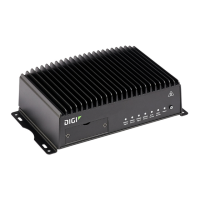Remote management Using Simple Network Management Protocol (SNMP)
Digi TransPort WR Routers User Guide
172
Configure SNMPv1 and SNMPv2
Command line
1. All SNMP versions are disabled by default. To enable support for SNMPv1 or SNMPv2c, enter:
digi.router> snmp v1 on
OR
digi.router> snmp v2c on
2. If using SNMPv1/v2c communities, configure a name for each community. For example:
digi.router> snmp-community 1 community public
3. The community access level defaults to read-only. To set the access level to read-write, enter:
digi.router> snmp-community 1 access read-write
4. Configure an IP filter that allows SNMP traffic to be received by the TransPort device. For
example, to allow SNMP packets from IP host 192.168.1.200 over LAN 1, the commands are as
follows:
digi.router> ip-filter 1 description “Allow SNMP from 192.168.1.200”
digi.router> ip-filter 1 dst-ip-port 161
digi.router> ip-filter 1 src lan1
digi.router> ip-filter 1 src-ip-address 192.168.1.200
digi.router> ip-filter 1 state on
5. Save the configuration.
digi.router> save configuration
Configure SNMPv3
Command line
1. All SNMP versions are disabled by default. To enable support for SNMPv3, enter:
digi.router> snmp v3 on
2. For each SNMPv3 user, give the user a name of up to 32 characters:
digi.router> snmp-user 1 user joe
3. Set the authentication type for the SNMPv3 user (none, md5, or sha1). To use privacy (DES or
AES), the authentication type be either md5 or sha1.
digi.router> snmp-user 1 authentication sha1

